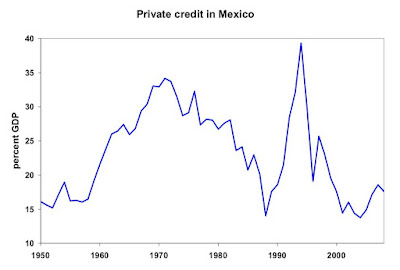MEXICO EVOLUTION: PART 1
1910–1928: "Revolución" and reconstruction
In 1910 in
Mexico started the “Revolution” or civil war with the power of Francisco I.
Madero led an uprising against Díaz, which originated a reduction in the
capital and a big fall in the population as a result of the armed conflict and the migration to the USA.
The
World War I began in 1914 and finished in 1918, Mexico was a neutral country in
it, the mexican president had other priorities, as Mexico was just beginning to
emerge from their own armed conflict.
During the
decade of 1920, Mexico had to be reconstructed after the end of the battle. In
this period, there was an increase in investment, nevertheless, the economic
situation was marked by high uncertainty.
There was an
increase in currency too (in inflation and in circulation). Other important
data is that the principal bank presented the monopoly over the emission of
currency. Before this event, private Bank took a place in money emission. In
1917 Constitution installed the national interest in their natural resources.
Growth was
lower than in the previous period. Real GDP per working-age person grew up to
0.4% per year.
1928–1950: Great Depression and recovery
Great Depression
had a long negative impact on economic activity all over the world. Still,
Mexico didn´t fell the effects of it as directly as other States.
Between 1928
and 1932, real GDP per working-age person fell by 7% per year. Exports and
imports fell. Tax revenue fell 25% and fiscal expendires were diminished.
Mexico started
to grow again after the Depression by many structural reforms like the
nationalization of the oil industry in 1938, the railroad nationalization in
1930, etc.
Until 1935 the
Great Depression affected in a bad way the money supply and the price level.
Over the entire
1928-1950 period, real GDP pero working-age person grew at 1.3% per year due to
the combianition of the fall until 1932 (7% per year) and the recovery in the
following years at a rate of 3.7% per year. In general average yearly inflation
was at 6.5 % per year (measured with the GDP deflator).
During this period, specifically over 1938 and 1945, the World War II took place. Although Mexico did not participate in such international conflict and stayed aside remaining neutral, this historical event is noteworthy as it affected Mexico indirectly. In contrast to what this war meant for the implicated countries, it brought Mexico positive effects.
During this period, specifically over 1938 and 1945, the World War II took place. Although Mexico did not participate in such international conflict and stayed aside remaining neutral, this historical event is noteworthy as it affected Mexico indirectly. In contrast to what this war meant for the implicated countries, it brought Mexico positive effects.
1950–1970: Import substitution and catch-up growth
During the 50s,
the government undervalued the peso to reduce the costs and spent massivly in
public infrastructure: highways, health, oil, and education.
At the
beginning of the 1960s the gobernment took the decision of protecting the
domestic product and imposing import taxes and tarifffs; private sector begun a
process of Mexicanization of the economy.
By 1970 Mexico had broaden its export and developed into a largely
self-sufficient for most
consumer goods. For other goods, there was a big quantity of import
substitution. These products were mainly intermediates and capital goods.
The increase in
GDP arised at the same time as urban growth did. Gross fixed capital
formation grew at 10.3% between 1963 and 1970, increasing the investment to GDP
ratio to 18.5 % in 1970.




Comentarios
Publicar un comentario